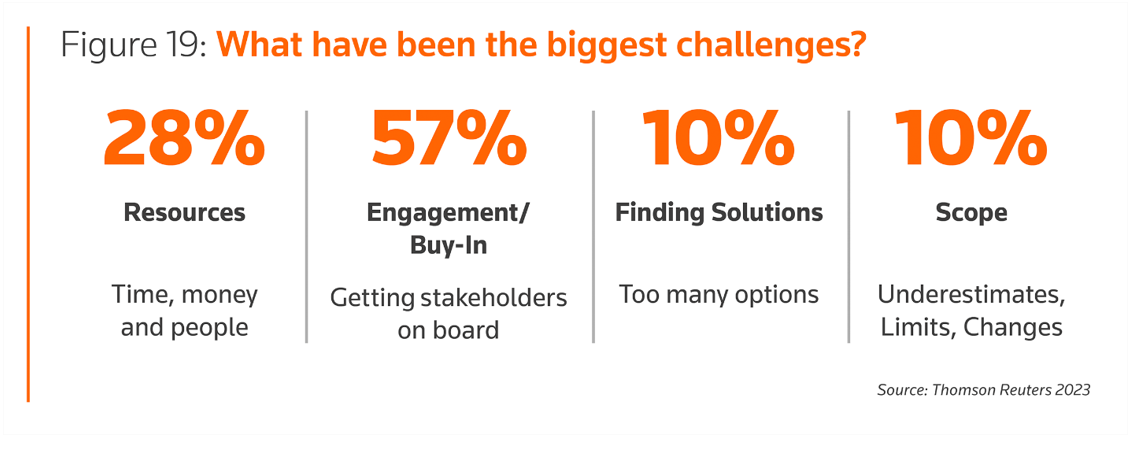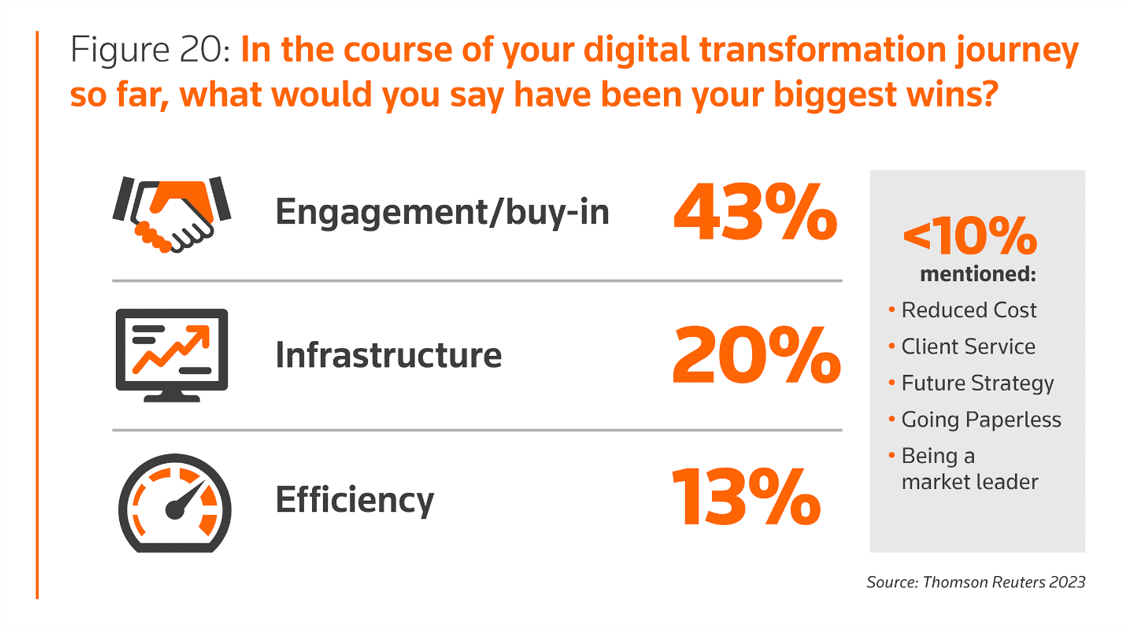Encouraging engagement is the biggest challenge for those law firms that are looking to tie digital transformation initiatives to their overall strategy. But those that achieve buy-in also say it’s their biggest win — with an impact beyond just technology
For many law firms, tying digital transformation initiatives to overall firm strategy is a relatively new concept. In fact, just 54% of law firms surveyed had a digital transformation strategy at the C-suite level, and of those with a strategy, 70% had only adopted it within the past five years, according to a recent survey from the Thomson Reuters Institute.
And yet, law firms still have positive feelings about how their digital transformation initiatives are coalescing with overall firm strategy. More than 80% of survey respondents called digital transformation highly important or central to firm strategy, while more than 75% of those with a digital strategy rated the strategy’s success as a 7-out-of-10 or above.
So how are law firms squaring their digital strategy optimism with the nascent nature of said strategy? Is their happiness around digital strategy initiatives unfounded?
Not necessarily. Although the paths to digital strategy success vary between firms, the survey revealed a commonality among respondents: Buy-in with technology initiatives remains a critical challenge at many law firms, and tying digital transformation to strategy allows firm leaders a way to encourage engagement among firm attorneys and professionals that may not have otherwise been invested.
The challenge and the win
Interestingly, most law firm leaders don’t believe their biggest challenge around digital strategy has to do purely with software and technology at all. More than half (57%) of respondents said that engagement and buy-in or simply getting stakeholders on board was their biggest digital strategy challenge, followed by resources (28%), properly scoping the project (10%), and finding the right solutions among a wealth of options (10%).
 Often, those surveyed noted that while many people within the firm recognize that technology can be helpful, getting them to actually engage with strategy formation and implementation can be difficult. “It is not sexy work,” said one Canadian law firm partner. “Getting people to understand that this is a necessity to survive has been hard.”
Often, those surveyed noted that while many people within the firm recognize that technology can be helpful, getting them to actually engage with strategy formation and implementation can be difficult. “It is not sexy work,” said one Canadian law firm partner. “Getting people to understand that this is a necessity to survive has been hard.”
A C-suite member of a U.S. law firm also bemoaned the pace of change at many larger firms, noting: “The adoption change has been hard on us being a larger firm, so getting everyone to buy in has been tough.”
However, once law firms actually tackled engagement and buy-in, they often found tangible rewards waiting on the other side. In addition to citing getting engagement and buy-in as their biggest challenge, 43% of survey respondents also named engagement and buy-in as their biggest win in implementing a digital strategy. And this was even over commonly cited technology-related outcomes like better infrastructure (20%) and greater efficiency (13%).

In some cases, digital strategy initiatives have helped amplify the voices of changemakers within firms who may have previously been drowned out. One Canadian law firm COO said their biggest win has been “finding champions that already know how to use the technology and amplifying their positive stories and how it has helped them.”
But in other cases, tying digital transformation to strategy has helped firms create new champions. One member of a U.S. law firm’s C-suite explained that after undertaking the digital strategy process “it’s been great having lawyers understand the digital transformations and having lawyers come to us with their own ideas.”
Another Australian law firm leader added that their “biggest win is probably a mindset shift to the adoption of new ways of working. COVID was very, very helpful in that.”
Getting there
The process by which many law firms have achieved that engagement and buy-in has varied — while nearly three-quarters of survey respondents said their firms have integrated their digital strategy as part of their overall strategy, the remainder reported having digital transformation as its own standalone initiative.
However, particularly for law firms that have been successful, a few common trends emerge. Among firms that have completed instituting a C-suite level digital strategy, more than two-thirds (69%) said their digital strategy came with a formal change management program. Even more (74%) said their digital strategy included a structured internal communication program.
At many firms, that communication program means multiple types of communication as well as constant outreach. More than two-thirds of respondents said the launch of their digital strategy included multiple processes, including firm-wide emails (73%); intranet posts (73%); communications at the practice, office, or department level (73%); and partner conferences (70%).
But crucially, these percentages also stayed largely consistent — the better to provide updates throughout the digital strategy implementation. The survey showed that more than half maintained their communications at the practice, office, or department level (70%); firm-wide emails (66%); intranet posts (64%); and partner conferences (59%) as the strategy process progressed.
Buy-in with technology initiatives remains a critical challenge at many law firms, and tying digital transformation to strategy allows firm leaders a way to encourage engagement among firm attorneys and professionals that may not have otherwise been invested.
“I think more focused leadership has been seen,” explained one C-suite respondent out of a large U.K. law firm. “I think firm-wide training [helps] getting people up to the learning curve of general transformation and then to embed alternative technology and workflows to current processes.”
The key, added one large law firm leader out of Europe, is using those communications to prove the digital strategy’s value to the firm. “We have provided value to our lawyers and then get partners to buy in. We start with products that provide most value to lawyers and find a dedicated team that can work with the right experience,” they explained.
That’s not to say that firm processes for collecting engagement and buy-in can’t improve. Crucially, just 56% of firms with a digital strategy have a structured process for collecting feedback on that strategy from its people. Even fewer (34%) have a process for collecting strategy feedback from clients, a worrying number when one of the primary goals of digital strategy initiatives is greater client service.
Regardless, it’s clear that establishing engagement and buy-in as one of the core tentpoles of a successful digital strategy initiative has resulted in law firms feeling that they’ve accomplished something substantial. And in some cases, those wins can translate beyond technology to affecting firm work at large.
“I think the biggest win is actually having people appreciating that you can’t do things the old way,” one Canadian managing partner revealed. “Especially if you’re talking about a certain culture in the firm, change is not necessarily an easy thing.”







